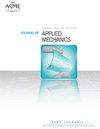基于黏结带的均匀和分层半空间中受法向和剪切表面牵引的分层接触力学分析
IF 2.8
4区 工程技术
Q2 MECHANICS
引用次数: 0
摘要
采用有限元方法对弹性和弹塑性均质半空间和层状半空间中由于压痕和滑动引起的法向和剪切表面牵引引起的界面分层进行了接触力学分析。分层界面处的表面分离受基于表面的黏聚带本构律控制。基于以界面法向与剪切力二次关系为例的损伤起裂准则,采用混合模式加载时界面节点对的临界分离距离来确定界面分层的起裂程度。刚度退化的特征是界面黏结强度与标量退化参数的线性关系,该参数取决于临界有效黏结强度对应的有效分离距离和由混合模式加载临界断裂能准则定义的完全退化刚度。分层剖面、地下应力场和塑性发展的数值解揭示了压痕深度和滑动距离对不同弹塑性、界面内聚强度和层厚半空间界面分层的影响。模拟结果揭示了层和衬底材料属性在界面分层上的不匹配。本研究的一个显著贡献是建立了一种用于开发多层结构塑性累积损伤模型的计算方法。本文章由计算机程序翻译,如有差异,请以英文原文为准。
A Cohesive-Zone-Based Contact Mechanics Analysis of Delamination in Homogeneous and Layered Half-Spaces Subjected to Normal and Shear Surface Tractions
A contact mechanics analysis of interfacial delamination in elastic and elastic-plastic homogeneous and layered half-spaces due to normal and shear surface tractions induced by indentation and sliding was performed using the finite element method. Surface separation at the delamination interface was controlled by a surface-based cohesive zone constitutive law. The instigation of interfacial delamination was determined by the critical separation distance of interface node pairs in mixed-mode loading based on a damage initiation criterion exemplified by a quadratic relation of the interfacial normal and shear tractions. Stiffness degradation was characterized by a linear relation of the interface cohesive strength and a scalar degradation parameter, which depended on the effective separation distances corresponding to the critical effective cohesive strength and the fully degraded stiffness, defined by a mixed-mode loading critical fracture energy criterion. Numerical solutions of the delamination profiles, the subsurface stress field, and the development of plasticity illuminated the effects of indentation depth and sliding distance on interfacial delamination in half-spaces with different elastic-plastic properties, interfacial cohesive strength, and layer thickness. Simulations yielded insight into the layer and substrate material property mismatch on interfacial delamination. A notable contribution of the present study is the establishment of a computational methodology for developing plasticity-induced cumulative damage models for multilayered structures.
求助全文
通过发布文献求助,成功后即可免费获取论文全文。
去求助
来源期刊
CiteScore
4.80
自引率
3.80%
发文量
95
审稿时长
5.8 months
期刊介绍:
All areas of theoretical and applied mechanics including, but not limited to: Aerodynamics; Aeroelasticity; Biomechanics; Boundary layers; Composite materials; Computational mechanics; Constitutive modeling of materials; Dynamics; Elasticity; Experimental mechanics; Flow and fracture; Heat transport in fluid flows; Hydraulics; Impact; Internal flow; Mechanical properties of materials; Mechanics of shocks; Micromechanics; Nanomechanics; Plasticity; Stress analysis; Structures; Thermodynamics of materials and in flowing fluids; Thermo-mechanics; Turbulence; Vibration; Wave propagation

 求助内容:
求助内容: 应助结果提醒方式:
应助结果提醒方式:


